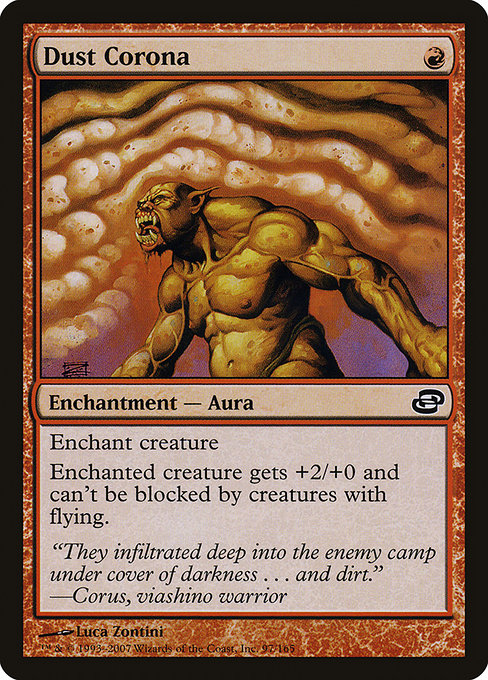
Image courtesy of Scryfall.com
Design Risks in Dust Corona: A Case Study in Bold MTG Thinking
In the wider tapestry of MTG design, few cards embody a deliberate risk-reward philosophy as cleanly as Dust Corona. Released in Planar Chaos, a set famous for color-shifting experiments and bold reimagining of familiar mechanics, this common rarity Enchantment — Aura showcases a one-mana aura that both powers up a creature and quietly reshapes how combat can play out. It’s a perfect lens for fans who love the tension between risk and payoff 🧙♂️🔥. Dust Corona isn’t just a buff; it’s a design dare that asks: how far can simple words push a dynamic game state without breaking the curve?
Dust Corona costs a single red mana, a cipher that immediately positions it within aggressive, tempo-oriented archetypes. Red has long thrived on fast, risky plays: bolstering a creature's brute force or curling the battlefield around an opponent’s open tempo. The enchantment’s text—“Enchant creature. Enchanted creature gets +2/+0 and can't be blocked by creatures with flying.”—packs a complex punch for a common card. The choice to attach a straightforward aura to a creature, while layering in a nuanced constraint against flying blockers, is a bold move. It transforms a straightforward buff into a strategic headfake: you’re elevating the risk of facing a flying defender who remains a non-factor against your ground plan, or you’re inviting an opponent to deploy blockers that suddenly become far less relevant. It’s the kind of line-by-line design that creates meaningful decisions across multiple turns, not just a single burst of damage 💎.
From a design-risk perspective, Dust Corona operates at a sweet spot that Planar Chaos was crafted to explore: it challenges the expectations of red’s typical play patterns by injecting a nuanced form of evasion. By making the buff contingent on a non-flying countermeasure, the card nudges players to think about what blocks and what doesn’t in a meta where flyers often dominate combat math. The result is a card that feels both familiar and surprising—an aura so modest in mana cost that it should be a no-brainer, yet nuanced enough to influence how your board develops over several turns ⚔️. It’s the sort of risk that pays off when the surrounding set design can accommodate stab-in-the-dark experiments, rather than punishing them with overpowered blowouts.
Why it stands out in a crowded color pie
- Strategic clarity: A one-mana aura that affects combat decisions, rather than just stats, gives players a clean, memorable choice each time it’s drawn. The text is precise, leaving little room for misreadings, which is essential for a common card that might rotate through hundreds of games in a format.
- Color identity inside a colorless niche: Red is all about speed and risk, and Dust Corona fits that ethos while introducing a tactical counterpoint to flying-heavy boards. The result is a card that feels thematically authentic and mechanically adventurous at once 🧙♂️.
- Low rarity, high conversation value: As a common, Dust Corona demonstrates that powerful ideas don’t need to be rare to spark strategic discussions about tempo, evasion, and the kinds of constraints that shape deckbuilding for years to come 🔥.
Flavor text, art, and lore reinforce the risky flavor of Planar Chaos as a whole. The litheness of Luca Zontini’s illustration, paired with a flavor line that hints at infiltration and cunning, mirrors the card’s mechanical cunning. This is a design that rewards players for recognizing the interplay between buffing your own creature and narrowing what blocks it, especially when you’re racing toward a crucial moment on the battlefield 🎨.
In the broader MTG community, Dust Corona also serves as a reminder of how a single aura can ripple through deckbuilding decisions. When you slot it into a red-based creature deck, you’re not just boosting a creature; you’re shaping when and how your opponent can contest combat. The timing matters almost as much as the buff itself, and that is where the design truly shines 🧙♂️. Even though it’s not a flashy marquee piece, it created a lane for thoughtful, tempo-forward play that persists in players’ minds long after the match ends.
From a collector’s vantage point, the card’s foil treatment, rarity, and the enduring curiosity around Planar Chaos’s color-shifting experiments add to its charm. Its nonfoil price sits modestly in the spectrum, while foils offer a touch more sparkle for collectors who relish finer printings and the lore of early-2000s MTG experimentation. Dust Corona’s value isn’t just monetary; it’s a design artifact—proof that a small, clever idea can leave a lasting imprint on how people think about combat, constraints, and creative risk-taking in card design 🧲.
For players who enjoy the blend of risk, reward, and precise wording, Dust Corona remains a go-to example of how a one-card decision can recalibrate a whole game plan. The aura’s purity—no complicated triggers, just a buff and a blocking constraint—lets the mind wander to all the “what if” scenarios that define truly strategic play. It’s the kind of card that invites you to sketch a rough plan, adjust on the fly, and savor the moment when your opponent discovers they can’t block your airborne plans with their flyers, thanks to Dust Corona’s ground-level power ⚔️.
Slim Phone Case for iPhone 16 Glossy Lexan Ultra-ThinMore from our network
- https://transparent-paper.shop/blog/post/craft-seasonal-invitation-templates-for-festive-events/
- https://blog.digital-vault.xyz/blog/post/how-to-maintain-brand-consistency-using-canva/
- https://blog.digital-vault.xyz/blog/post/charting-lulu-vengeful-hollyphant-art-reprint-frequency/
- https://blog.digital-vault.xyz/blog/post/reborn-hero-how-inclusion-rate-impacts-mtg-win-probability/
- https://blog.digital-vault.xyz/blog/post/uncovering-inspiration-for-new-digital-product-ideas/